by Amy Levad
Amy Levad attended YTI as a scholar in 1996, and served on staff in 2004. She is an associate professor of moral theology at the University of St. Thomas in St. Paul, Minnesota. Her current work explores Christian responses to mass incarceration, particularly drawing on sacramental and liturgical ethics to argue for commitment to work for social justice and criminal justice reform. She is the author of Redeeming a Prison Society: A Liturgical and Sacramental Response to Mass Incarceration (2014) and Restorative Justice: Theories and Practices of Moral Imagination (2011).
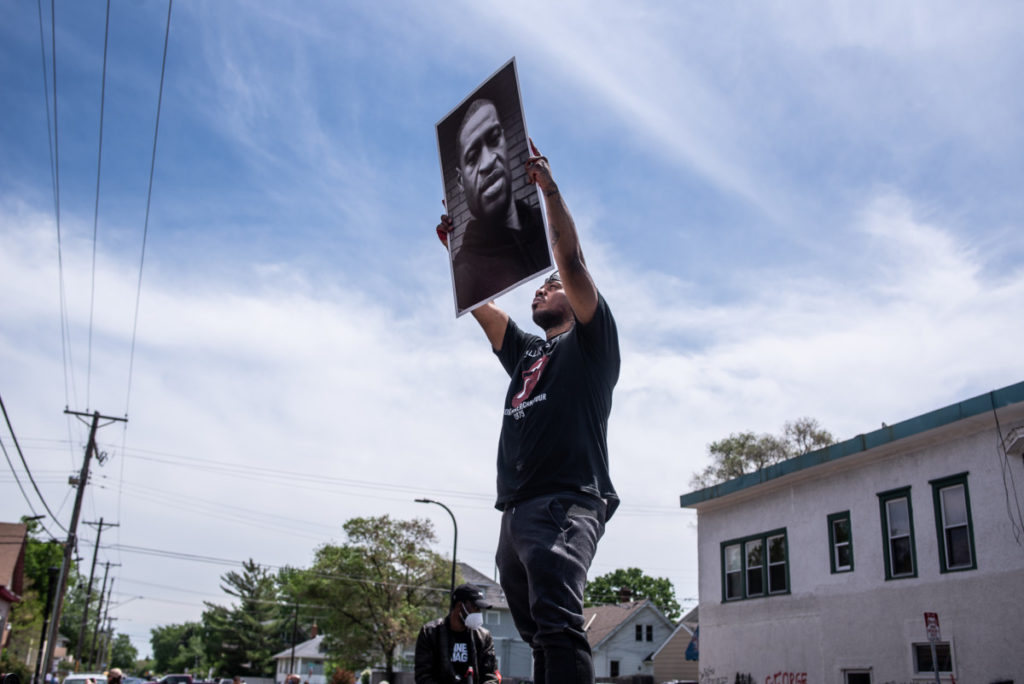
I have thought a lot about scarcity and abundance over the last few weeks.
George Floyd was murdered by police officers in Minneapolis on May 25, Memorial Day. On the following day, I was in the throes of grading finals on the other side of the Mississippi when I checked Facebook for distraction, like professors do. I was assessing my students’ final reflections on mass incarceration, part of an upper-level undergraduate theology course that explores how Christian ideas, practices, and structures have helped build and maintain white supremacy in our culture—as well as possibilities for restorative and transformative theologies in response. The topic weighs on one’s soul, so flipping through Facebook pictures and posts usually provides a lighthearted reprieve. The video I found throughout my feed was horrifying, and my distraction turned heavy. I could not concentrate any longer, and not because of the usual excuses that professors give.
After two weeks of cooking every meal for my family during an unexpected online semester, I ordered takeout. We’ve been trying to support restaurants that we want to exist after this pandemic, and so I called Hola Arepa, a little place in Minneapolis that grew up from a food truck to be one of the best places to eat in the Twin Cities. It is located near Cup Foods, where Floyd was murdered. Not thinking everything through yet (for instance, the proximity of Hola Arepa to Cup Foods), I jumped in my car, crossed the Ford Parkway bridge, and quickly found myself watching the first protests coalesce. For blocks around 38th and Chicago, people wearing face masks stood six feet apart from each other. Many protestors who I imagine didn’t feel comfortable with those steps of social distancing drove around with hastily written cardboard signs: “I Can’t Breathe,” and “No Justice, No Peace.” I honked my horn in support, and began wondering, What are we going to do? How are we going to protest this in a pandemic? After weeks of biking around the cities without worrying about traffic (stay-at-home orders left empty streets), I was now in a traffic jam as I watched, and began to participate in, protests that I pray transform my cities and our world.
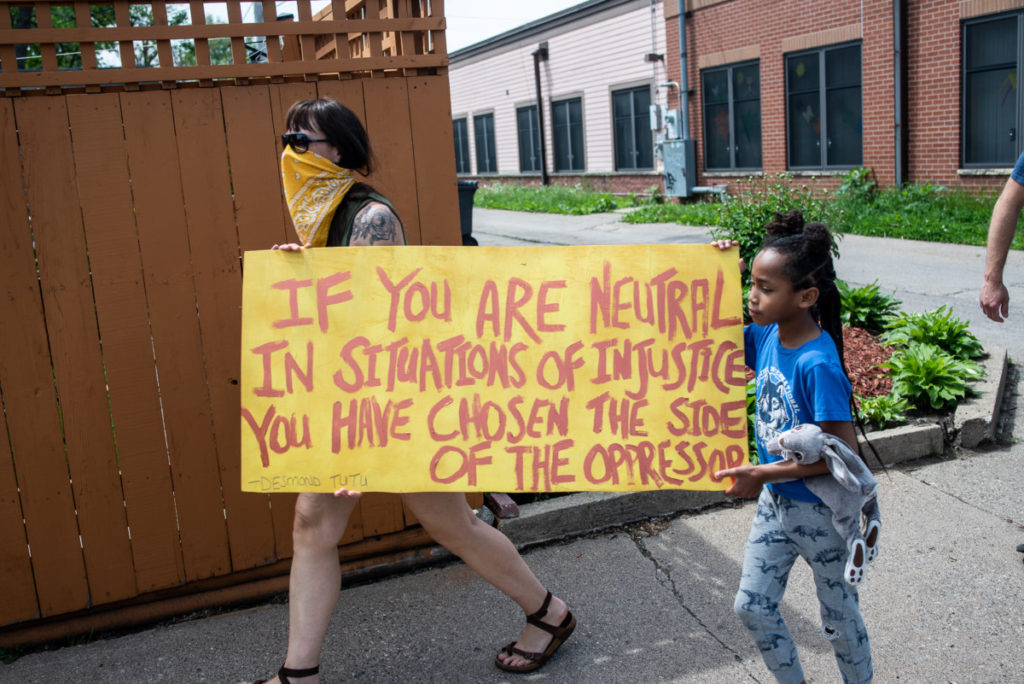
In the coming days, residents of the Twin Cities figured out how to protest in these conditions. This article describes how generations of activism here laid the groundwork for what we are now experiencing. Parts of both cities burned as white supremacists infiltrated the protests in order to seed racist imagery of rioters and looters. In Minneapolis, the destruction centered around Lake Street and Minnehaha Avenue. The surrounding neighborhood is largely white (like most of Minnesota), but also includes large Latinx and African immigrant populations. One of the first black neighborhoods in the city lines the corridor between Minnehaha and Hiawatha, which is built up around train tracks and grain elevators that have been used for over a century; many early African-American residents of Minneapolis worked for the railroads there. One shopping center on Lake and Minnehaha has a Cub Foods grocery store and a Target, as well as the usual array of stores and businesses that you would find in many strip malls around the country, especially in economically underserved neighborhoods: dollar stores, check cashing places, pawn shops, cell phone stores. Across the street from Target: the Third Precinct of the Minneapolis Police Department.
There are also a number of small, innovative businesses and non-profits in the area. Last year, I bought my bike at the Hub Bike Co-op, a worker-owned business. I regularly go to Moon Palace books, which sells new and used books, but they have a very particular protocol for the books that they accept for resale because they support a progressive and inclusive vision of the world. During the protests, the bookstore kept milk in the fridges of their café for protestors needing treatment for tear gas. In the lot between the Hub and Moon Palace, the Midtown Farmers Market meets throughout the summer. It was one of the first farmers markets in the Twin Cities to accept SNAP and became an example for farmers markets throughout the region. Gandhi Mahal Restaurant is known for its sustainable food practices and just economic model for treating its employees—and for its delicious Bangladeshi food. When the restaurant burned, the owner, Ruhel Islam, posted on Facebook, “Let my building burn. Justice needs to be served, put those officers in jail.” Migizi, next to Gandhi Mahal, is a non-profit organization that has supported Native American youth and communities since 1977. As their building burned, Brian Dragonfly captured the flame and lit a lantern, which he took across the alley to Ingrid Rasmussen, the pastor of Holy Trinity Lutheran Church, so that the church could tend the fire until Migizi can be rebuilt. This church has worked for racial justice and affordable housing for decades, including building two large apartment complexes on its property. These institutions were at the center of protests, providing resources, medical care, and sanctuary to the people gathered to call for justice, and they will be at the center, I hope, of rebuilding. Throughout the early days of the protests, I would venture out to this neighborhood. It has always been one of my favorite places in the Twin Cities. First, I took some paper towels to Holy Trinity to help with their medic station. My mother and I dropped some bags of food at Little Earth, a non-profit organization serving the American Indian community in South Minneapolis. Each day, I was seeking something to do, and I was leery of large crowds because my mother lives with us, and at 74, she is vulnerable to Covid-19. Curfews, helicopters, the smell of sulfur in the air, fear of white supremacists in cars without license plates roaming the streets and looking for things to burn, concern about a cousin and her black partner who live near the Third Precinct, distress that such conditions are not necessarily foreign to my black and brown neighbors while I am cushioned by privilege—this stress fostered a desire to take any kind of action, also knowing that all kinds of action will be inadequate.
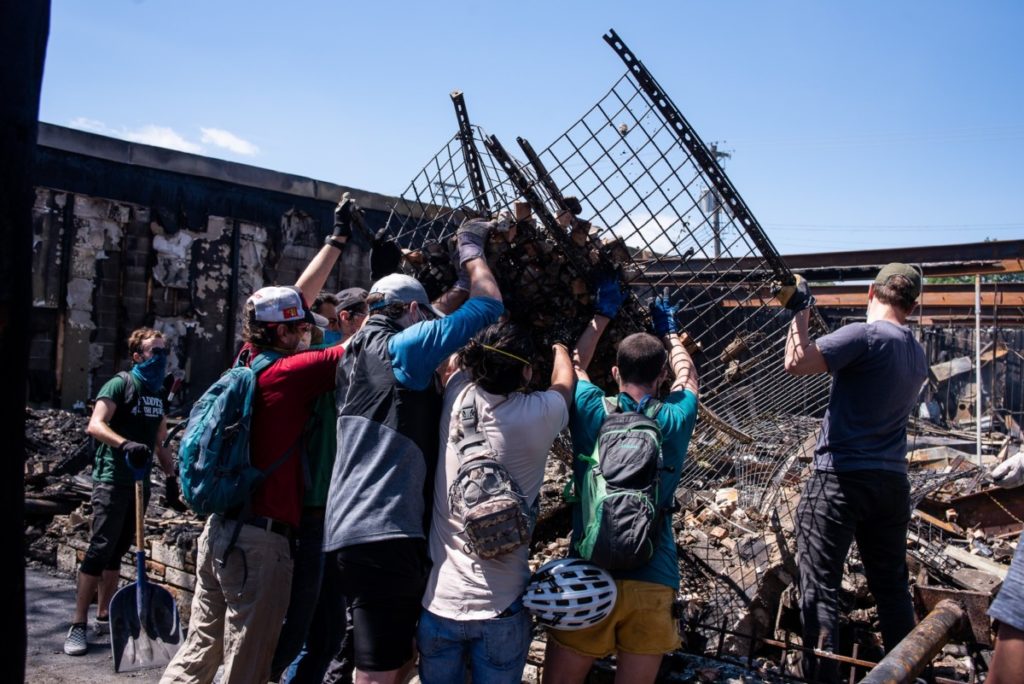
On Pentecost, I woke up with more sleep than many of my neighbors (but less sleep than I would have liked) ready to find another way to take action. I ventured out to the suburbs to buy groceries because all of the stores near us were closed, either because of damage or fear of it. The store was much plusher than those I’m accustomed to (and mine are pretty nice), and I was in a rush. I found myself, clad in a mask, inordinately upset with a white woman and her teenage daughter who weren’t wearing masks. Were they thinking, I can’t breathe with one of those on!? We are at the crossroads of a pandemic and the eruption of a long simmering social justice crisis, and the least you could do is put on an f-ing mask! I wasn’t terribly charitable in my thoughts. A friend whose elderly parents landed in the hospital with Covid-19, and who are recovering, assures me that my rage was appropriate. (I have recently taken, in times of stress and whenever I see folks without masks in grocery stores, to say loudly to no one in particular, “Wow, masks! They are amazing!”)
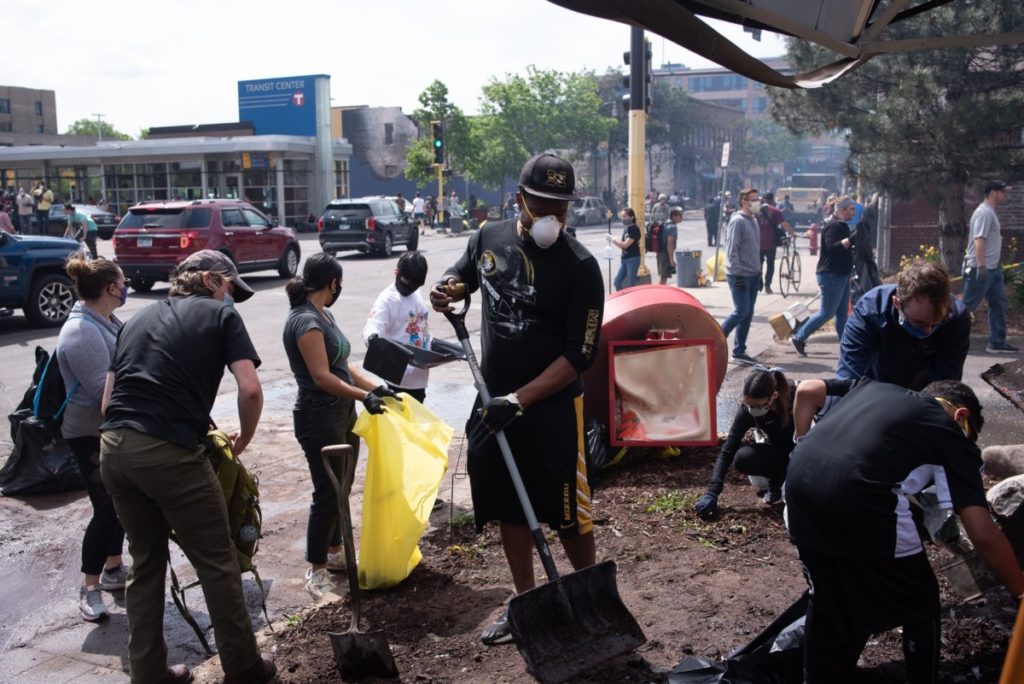
I dropped most of the groceries at home for the week, grabbed a push broom and a dustpan to head to Lake and Minnehaha for the cleanup. I supposed that I could social distance (is that a verb now?) while sweeping up some ash. After parking, I found myself at Holy Trinity and saw that the pressing need was sorting grocery donations that were pouring onto their front lawn. I put aside my plans of sweeping and followed the plans of other people with sorting. Piles of canned beans and veggies, soup, cereal, tortillas, and bread. Hills of diapers and toilet paper. Volunteers picked up whatever they could to help out. Folks from the neighborhood grabbed what they needed. Their grocery stores have been destroyed, and mass transit was closed. If you don’t have a car, you don’t have food, and a lot of people in this neighborhood don’t have a car. Everyone wore a mask. At some point, a woman dropped off a bag full of beautiful homemade masks, and I started handing them out. Many people were desperate for them. A man came by saying that the nearby Target was boarding up but had some food that hadn’t been damaged. Could someone pick it up? I drove over with my mom’s Prius, and people there helped me load it up with carton after carton of chicken broth and tomato soup. By the time I came back to the church, the operation had shifted from the front lawn to the creation of a warehouse in the basement. An hour or so later, the church had to stop accepting donations because they were already at capacity.
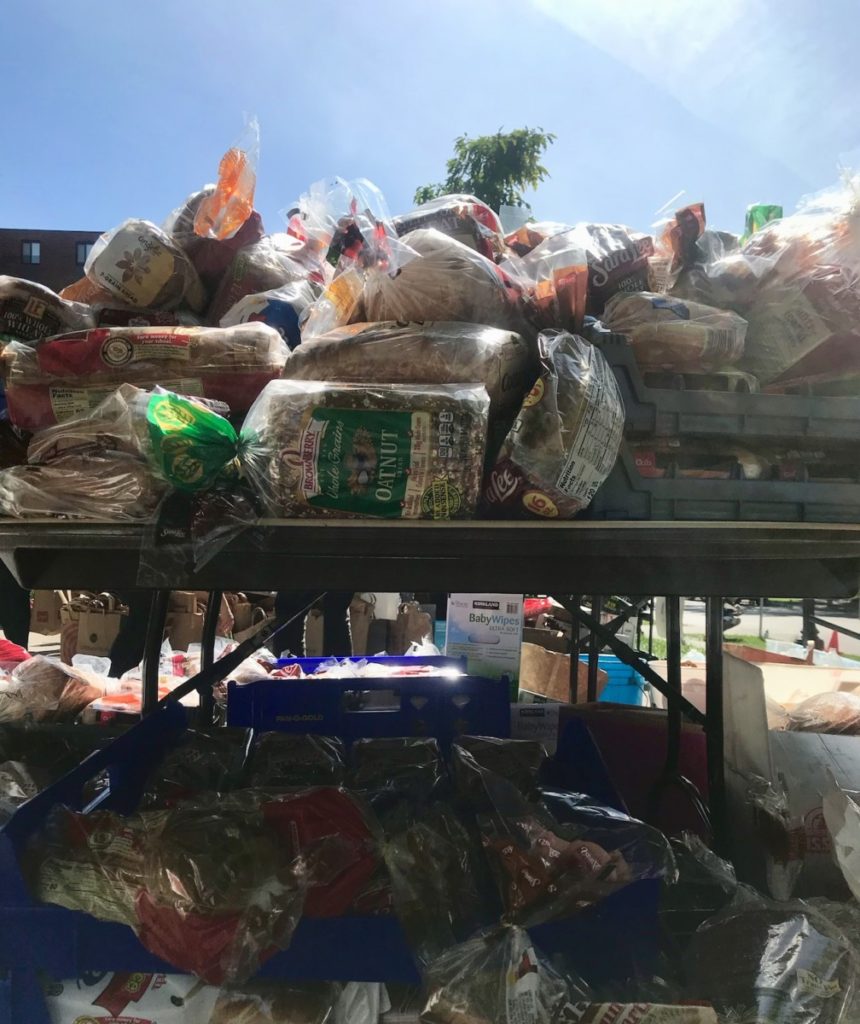
Over the next few days, the folks at Holy Trinity continued to adapt and develop their response. A few tables arrayed on the front lawn to sort donations became a warehouse, became a ragtag operation for distribution with toilet paper, personal hygiene products, cooking oil, diaper and wipes, and water, among other stations. Volunteers showed up and did whatever was necessary. I posted on Facebook that I knew where to take donations; if friends wanted to send money, I would buy supplies on their behalf. I approached a couple of neighbors about my plans, and they handed me $170 in cash. A few friends who couldn’t leave their houses because of the pandemic Venmo’d me funds. I made a run in the morning to Target, dropped it off, volunteered a bit, and returned home exhausted. My husband let me take a nap, but I was too worked up, and I impulsively put up a Facebook fundraiser for $1000. What the hell? A friend texted me as soon as it posted: “Your fundraiser will be met in 3…2…1…” I looked. She was right.
Friends from around the country entrusted me with their money, and I went to Target, and to Costco, and to Target, and to Costco. Maxi pads, which are preferred by many women in the neighborhood for cultural reasons, became a hot ticket item. Diapers, especially in sizes 4-6, were increasingly difficult to procure. Friends met me at stores so they could help push around the carts and fill up their cars. We emptied shelves of cooking oil. We watched suburban stores emptied as people from around the cities made runs for donations, not only to Holy Trinity, but to several pop-up distribution centers in the neighborhood, including at DuNord Craft Spirits and the YWCA. Over the last ten days, I have spent nearly $12,000 of friends’ and friends of friends’ money. At the end of last week, Pastor Ingrid handed me a jumble of cash that people had handed to her over the week. She asked me to go on another Costco run: cooking oil, peanut butter, maxi pads—always maxi pads. I paused to put the money in a nice pile and count it out. There were a few hundreds, a slew of fifties, a mess of twenties, one ten, a handful of fives, and a single one-dollar bill. I love that one-dollar bill. It speaks of an attitude of abundance, even perhaps for someone who might not have much. I make some assumptions here, but I imagine it as the widow’s mite. As of this writing, Holy Trinity is shifting in new ways, including hosting a Covid-19 testing facility at the request of the Minnesota Department of Health for protestors, volunteers, and clean-up crews. They have begun focusing on a few items that they are well situated to collect, store, and distribute, and that have been in highest demand. The need remains deep. Even with car and truck loads of supplies pouring into the church and other distribution centers, people in this neighborhood are desperate. Social unrest created a food desert overnight. All of the pharmacies have been burned to the ground. People who were already on the margins of our society have been thrust even farther out.
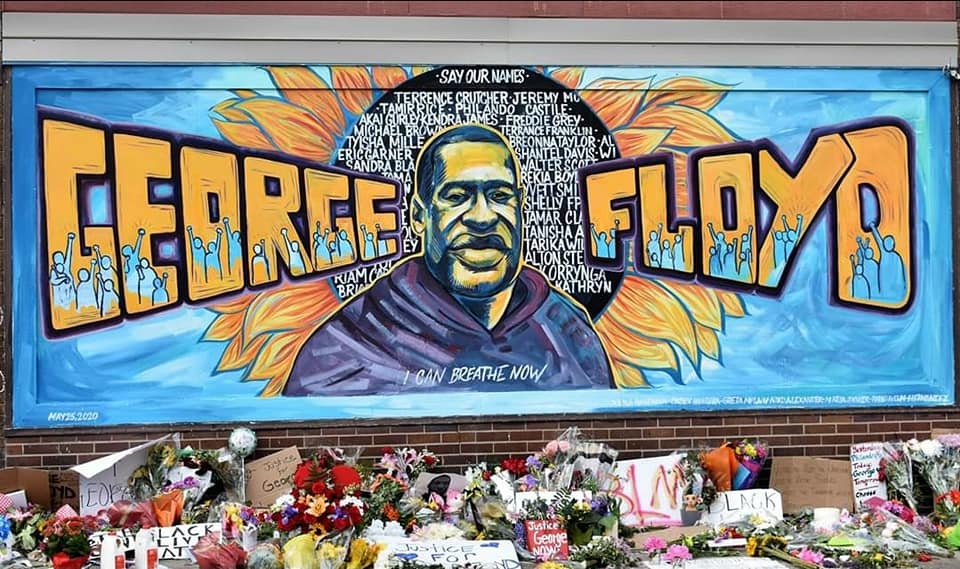
One of the responses to the pandemic was to hoard. Many people looked at the situation from a sense of scarcity. “There isn’t enough. I have to get mine. It doesn’t matter whether others get their needs met. In some cases, I will profit off of their desperation.” This reaction was a crystallization and amplification of how many of us go about our world even at a time when we’re relatively healthy; it’s just less obvious to those of us who are on the upside of it. I witnessed the lingering effects of hoarding as I found caps on basic necessities, responses of stores that needed to begin monitoring the behavior of their customers, many of whom were uninterested in the common good. I wanted to buy all of the maxi pads in Costco but could only buy one box per membership per day, a limit that the manager couldn’t work around because it was established in the computer system at corporate headquarters. I stood with others befuddled by these caps, sussing out what to do. Well, everyone should at least buy one. (I eventually found a workaround by shopping at Costco Business, where one can purchase all of the maxi pads they have.) As a society, we saw the damage caused by a sense of scarcity, by a fear that there is simply not enough, some people will not get what they need, and an insistence that I will not be one of those people.
What I saw over the last few days was a situation where people acted from a sense of abundance. There’s more than enough. I can share. What do people need? A pile of bread on a table in front of the church on my first day there, with the light shining behind it: like the loaves and fishes. This pile of bread grew into a warehouse, a distribution hub, and a testing center in a place where sacred flames are kindled and communities restored. These responses were necessary, charitable, and… a band aid in an emergency.
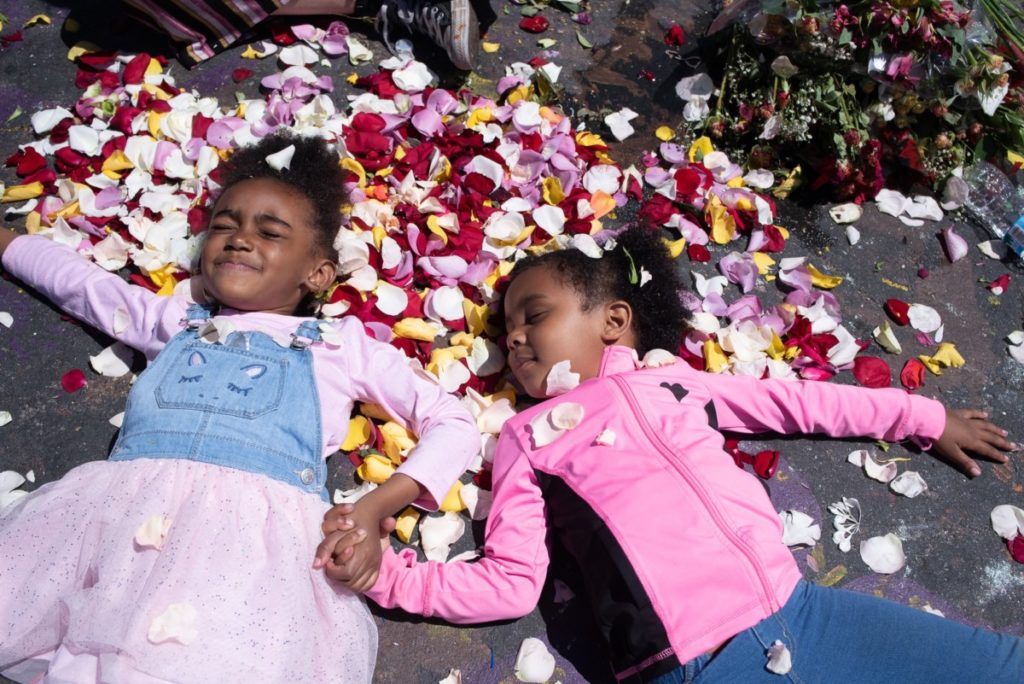
In Stand Your Ground: Black Bodies and the Justice of God, Kelly Brown Douglas describes our culture as one that defines whiteness as “cherished property” to be protected, with rights to exclude, claim land, stake out space, and indeed, breathe. Of course, this property is protected against the perceived threat that if black people are free and able to experience these rights, then they will take what is ours because there isn’t enough. This culture assumes scarcity.
In contrast, Douglas describes how black faith worships a God who calls us all to freedom. The Great High God empowers black people to endure the absurdities and contradictions of stand-your-ground culture, creating a restless spirit to dismantle the culture of death. For white people, this faith challenges us to recognize that our sin is built on denigrating other people. We have protected our whiteness at the cost of our souls. Our freedom lies in giving up our narratives of scarcity and learning a new story of abundance that comes from relationship. Hearing this story demands that we dismantle the systems and structures built to protect whiteness, and when we do so, we might find liberation from our sinfulness. We need to be liberated from this, so others might be liberated from the bondage of stand-your-ground culture. This vision, rooted in a vision of the Free God’s ultimate reign, calls us to recognize God’s abundance.
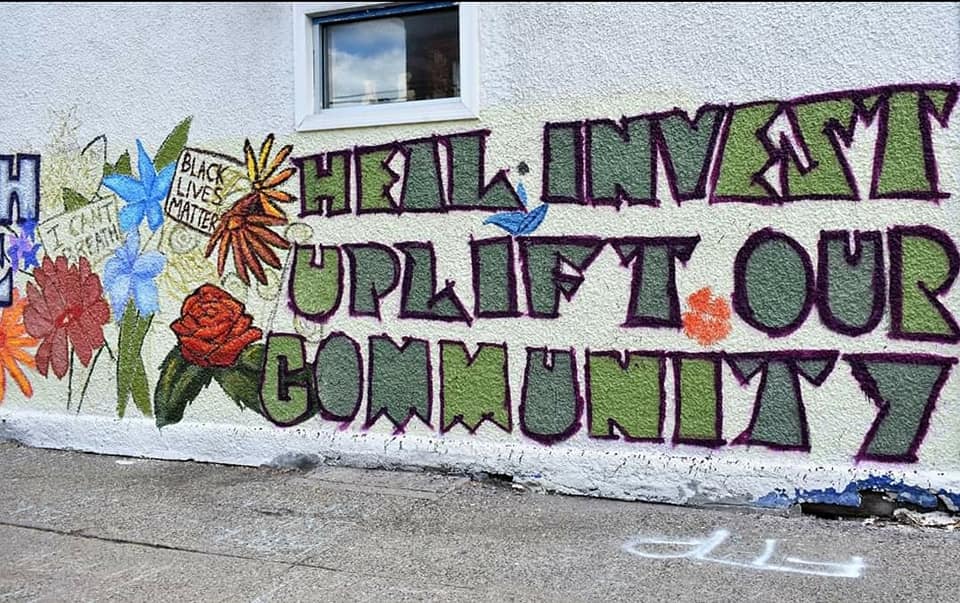
We are in what Douglas calls a “kairos time,” a decisive moment in history. These moments are chaotic and critical, yet God is fully present and provides openings to a new future by calling us to new relationship. As we build these relationships, the hungry must be fed, and we must do the necessary and charitable while recognizing that we are only putting on band aids. We must also do the work of justice, of dismantling systems and structures that protect whiteness. And white folks, we need to follow the prophetic leadership of people telling us that they can’t breathe. The protests have begun to do this work. A veto-proof majority of the Minneapolis City Council has committed to defund and dismantle the Minneapolis Police Department. The schools and parks have severed relationships with the department. Broader conversations about interlocking systems of injustice and inequality, between health care, education, employment, infrastructure, criminal justice, and so on, are gaining further ground. The impact has spread internationally, with calls for justice ringing around the world. And we are hearing his name: George Floyd. But also the names of so many others: Breonna Taylor, Ahmaud Arbery, Trayvon Martin, Jamar Clark, Philando Castille. And so many others.
As I think about those piles of food, about people wanting to give so much, and about people who are in such dire need because whole systems have collapsed under the weight of white supremacy, I ask: What if we maintain our sense of abundance in the coming days, weeks, months, and years? What if those of us who have enough recognize that we need not fear scarcity? There is enough. God is fully present. Where are there openings for a new future?
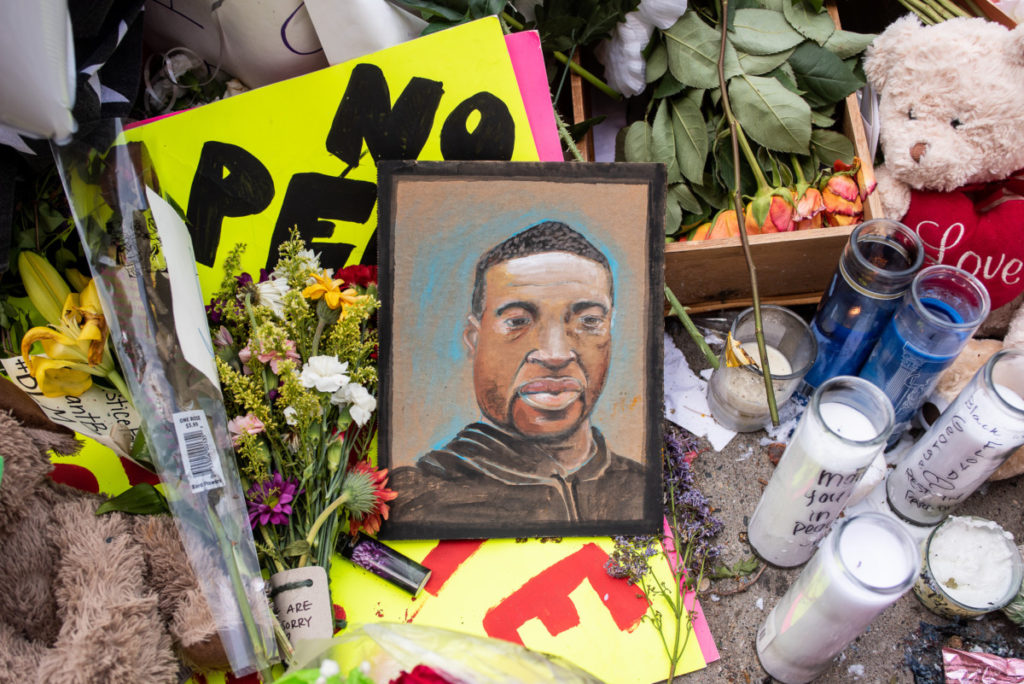
If you would like to contribute to the work of justice and love in Minneapolis and St. Paul, I recommend these organizations: